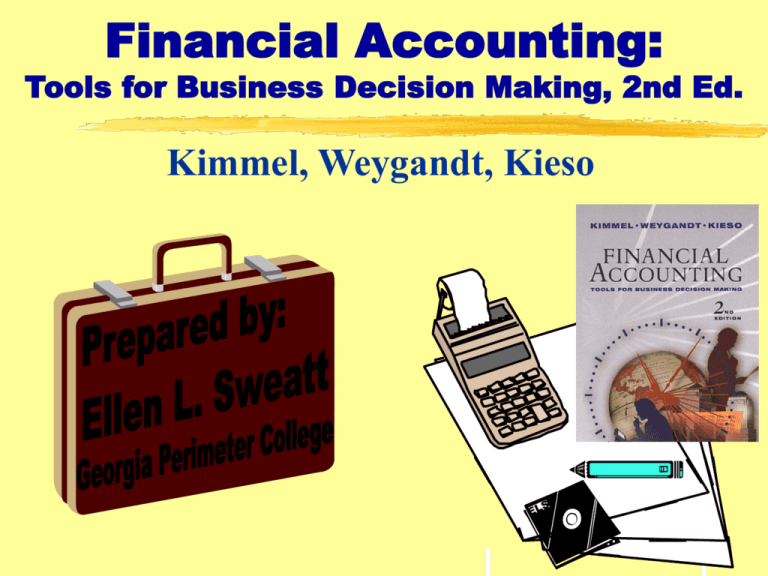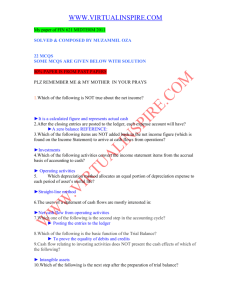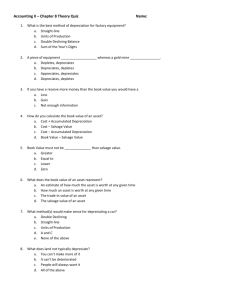
Financial Accounting:
Tools for Business Decision Making, 2nd Ed.
Kimmel, Weygandt, Kieso
1
Chapter 9
Chapter 9
Reporting and Analyzing
Long-Lived Assets
After studying Chapter 9, you should
be able to:
Describe how the cost principle applies to plant
assets.
Explain the concept of depreciation.
Compute periodic depreciation using the straightline method, and contrast its expense pattern with
those of other methods.
Describe the procedure for revising periodic
depreciation.
3
Chapter 9
Reporting and Analyzing
Long-Lived Assets
After studying Chapter 9, you should
be able to:
Explain how to account for the disposal of plant
assets.
Describe methods for evaluating the use of plant
assets.
Identify the basic issues related to reporting
intangible assets.
Indicate how long-lived assets are reported on the
balance sheet.
4
Plant Assets...
are resources that:
have physical substance
are used in the operations of a
business
are not intended for sale to
customers.
are recorded at cost.
cost consists of all expenditures
necessary to acquire the asset
and make it ready for its intended
use.
5
Plant Assets
Land - a building site
Land improvements
driveway
parking lots
fences
underground sprinkler systems
Buildings
Equipment
6
Types of Expenditures
Revenue Expenditure are immediately
charged against
revenue as an
expense.
Capital Expenditure increase the company’s
investment in productive activity.
7
Plant Assets
Cost is measured by:
the cash paid in a cash transaction,
or
the cash equivalent price paid when
noncash assets are used in
payment.
The cash equivalent price is equal to:
the fair market value of the asset
given up, or
the fair market value of the asset
received, whichever is more clearly
8
determinable.
Cost of Land Includes:
the cash purchase price
closing costs such as title and
attorney's fees
real estate brokers commissions
accrued property taxes and other
liens on the land assumed by the
purchaser.
9
Cost of Land Improvements
Include:
All expenditures necessary to make
the improvements ready for their
intended use.
10
Cost of Buildings Include:
All necessary expenditures
relating to the purchase or
construction of a building.
When a building is
purchased such costs
include the:
purchase price
closing costs (attorney's fees
title insurance)
real estate broker's
commissions.
11
Cost of Buildings Include:
Cost of making a building
ready for its intended use
consist of:
expenditures for remodeling
rooms or offices
replacing or repairing
roof
floors
electrical wiring
plumbing
12
Buildings
When a building is constructed, its
cost consists of:
the contract price
architect's fees
building permits
excavation cost
interest costs during
during construction.
13
Cost of Equipment Includes:
purchase price
sales tax
freight charges and
insurance during transit
paid by the purchaser
expenditures required in
assembling
installing and testing the
14
unit.
Equipment
Two criteria apply in determining
the cost of equipment:
the frequency of cost - one time or
recurring
the benefit period - the life of the
asset or 1 year.
15
Advantages of Leasing an
Asset Versus Puchasing
Reduced risk of obsolescence
Little or no down payment
Shared tax advantages
Assets and liabilities not reported
16
Depreciation
Applies to three classes of plant
assets:
Land improvements
Buildings
Equipment.
17
Depreciable Assets
The revenue-producing ability of an
asset declines during its useful life
because of wear and tear.
A decline in revenueproducing ability may
also occur because of
obsolescence.
18
Illustration 9-5
Depreciation is…
The process of allocating to expense the
cost of a plant asset over its useful life in a
rational and systematic manner.
A process of cost allocation, not a process of
asset valuation.
19
Land
Does not depreciate since its usefulness
and revenue producing ability generally
remain intact, or increase.
20
Accumulated Depreciation
The balance in Accumulated
Depreciation is not a cash fund.
21
Factors in Computing
Depreciation
Cost - historical cost of the asset.
Useful life - estimate of the expected
productive life in terms of:
time
units of out activity or output
Salvage value - an estimate of the
asset's value at the end of its useful
life.
22
Illustration 9-6
Factors in Computing
Depreciation
Depreciation Methods
Straight-line
Declining-balance
Units-of-activity
24
Affects of Depreciation
Depreciation affects the balance
sheet through accumulated
depreciation, which is reported
as a reduction from plant assets.
Depreciation affects the income
statement through depreciation
expense.
25
Straight-line Method
Depreciable Cost*
________________________________________________________________________________________________________
The asset's useful life measured in
years
*(cost of the asset less its salvage
value)
26
Straight-Line Depreciation
Formula
Illustration 9-8
27
Illustration 9-9
Straight-line Method
Is the most
widely used
method of
depreciation.
Depreciation
is the same
for each year
of the
asset's
useful life.
Year
28
Partial Year Depreciation
If an asset is purchased during
the year rather than on January
1, the annual depreciation is
prorated for the proportion of a
year it is used.
29
Illustration 9-10
Declining-Balance Method
Is an accelerated
method.
Accelerated
methods of
depreciation
result in more
depreciation in
the early years of
an asset's life
and less
depreciation in
the later years.
Year
30
Illustration 9-11
Units-of-Activity Method
The life of an
asset is
expressed in
terms of the
total units of
production or
the use
expected from
the asset.
Year
31
Depreciation and Income Taxes
The IRS allows corporate
taxpayers to deduct depreciation
when computing taxable income.
The IRS does not require the
taxpayer to use the same
depreciation method on the tax
return that is used in preparing
financial statements.
32
Depreciation and Income Taxes
Many large corporations use
straight-line depreciation in their
financial statements to maximize
net income.
At the same time they use a
special accelerated-depreciation
method on their tax returns to
minimize their income taxes.
33
Depreciation and Income Taxes
For tax purposes:
the straight-line method or
a special accelerated-depreciation
method called the
Modified
Accelerated
Cost
Recovery
System
The choice of depreciation method
must be disclosed in the notes to
34
financial statements.
Revising Periodic
Depreciation
When a change in an estimate is required,
the change is made in current and future
years but not to prior periods.
Significant changes in estimates must be
disclosed in the financial statements.
Extending an asset's estimated life reduces
depreciation expense and increases net
income for the period.
35
Ordinary Repairs
Expenditures to maintain
the operating efficiency
and expected productive
life of the asset.
Are usually small in amount
that occur frequently
throughout the service life.
36
Ordinary Repairs
Examples:
motor tune-ups
oil changes
the painting of buildings
the replacing of worn-out gears
Ordinary repairs increase Repair
Expense and are revenue expenditures.
37
Additions and Improvements
Costs incurred to increase the:
operating efficiency
productive capacity or
expected useful life of the plant asset.
Are usually material in amount and
occur infrequently during the period
of ownership.
Are capital expenditures.
38
Impairment
A permanent decline in the
market value of an asset.
Is written down to the new
market value during the year in
which the decline occurs.
39
Plant Asset Disposals
The depreciation for the fraction of
the year to the date of disposal
must be recorded.
Depreciation Expense
Accumulated Depreciation
8,000
8,000
Compute Book Value:
Book Value =
Cost - Accumulated Depreciation
40
Sale of Plant Assets
In the sale of an asset, the
book value of the asset is
compared with the proceeds
from the sale.
If the proceeds exceed the
book value a gain on disposal
occurs.
Conversely, if proceeds from
the sale are less than the
book value a loss on disposal
occurs.
41
Retirement of Plant Assets
Is recorded by decreasing
Accumulated Depreciation for the
full amount of depreciation taken
over the life of the asset.
The asset account is reduced for
the original cost of the asset.
The loss is equal to the asset's
book value at the time of
retirement.
42
Analyzing Plant Assets
The three measures by which
plant assets are evaluated are:
Average useful life
Average age of plant assets
Asset turnover ratio
43
Average Useful Life
Useful life of an assets is chosen by a
company.
By selecting a longer estimated useful
life:
A company spreads the cost of its
plant assets over a longer period of
time.
The amount of expense reported in
each period is lower and net income
is higher.
44
Illustration 9-19
Average Useful Life
On the other hand, a shorter
estimated useful live will result in a
lower reported net income.
Average Useful Life of Plant Assets =
Average Cost of Plant Assets
Depreciation Expense
45
Illustration 9-20
Average Age of Plant Assets
Most companies use straight-line
depreciation for financial
reporting.
Average age of plant assets =
Accumulated Depreciation
Depreciation Expense
46
Illustration 9-21
Asset Turnover Ratio
Two ways a company can increase
its return on assets:
Increase profit per sale-measured by profit margin ratio.
Increase its volume of sales-measured by the asset turnover
ratio=
Net Sales
Average Total Assets
47
Intangible Assets are
rights
privileges
competitive advantages
that result from ownership
of long-lived assets that do
not possess physical
substance.
48
Amortization...
Allocation of the cost of an
intangible asset to expense
over the shorter of:
its useful (economic) life
its legal life
40 years
49
Types of Intangible Assets
Patents
Copyrights
Trademark or Trade Names
Franchises and Licenses
Goodwill
PATENT
50
Patents
An exclusive right issued by the
U.S. Patent Office that enables
the recipient to manufacture,
sell, or control a patent for 17
years from the date of grant.
51
Patents
The initial cost of a patent is cash
or cash equivalent price paid to
acquire the patent.
Legal costs of protecting a patent
in an infringement suit are added
to the Patent account and
amortized over the remaining life
of the patent.
52
Research and
Development Costs
Because of the uncertainty
of identifying the extent
and timing of future
benefits, these costs are
usually recorded as an
expense when incurred.
53
Copyrights
Copyrights are granted by the
federal government giving the
owner the exclusive right to
reproduce and sell artistic or
published work.
Copyrights extend for the life of
the creator plus 50 years.
54
Impressionist
master Pierre
Renoir died in
1919…
therefore, anyone
can copy
A GIRL WITH A
WATERING CAN
or his other
paintings without
receiving
permission or
paying a fee.
Trademarks/
Trade Names
A word, phrase,
jingle,or symbol
that distinguishes
or identifies a
particular
enterprise or
product.
Trademarks Trade
Names
Franchises
A franchise is a contractual
agreement under which the franchiser
grants the franchisee the right
to sell certain products
to render specific services or to use
certain trademarks or trade names,
usually within a designated geographic
area.
58
59
Licenses
Operating rights granted by a
government body permit the
enterprise to use public property
in performing its service (i.e. the
use of airwaves for radio or TV
broadcasting).
60
Costs Associated with
Franchise or License
When costs can be identified with
the acquisition of the franchise or
license, an intangible asset
should be recognized.
Annual payments made under a
franchise agreement should be
recorded as operating expenses.
61
Goodwill
Goodwill represents the value of
all favorable attributes that relate
to a business enterprise,
including:
exceptional management
desirable location
good customer relations
skilled employees, etc.
62
Goodwill
Goodwill is recorded only when
there is an exchange transaction
that involves the purchase of an
entire business.
In other words, if you didn’t buy
it, it’s not on your balance
sheet.
63
Goodwill
When an entire business is
purchased, goodwill is the excess
of cost over the fair market value
of the net assets (assets less
liabilities) acquired.
64
Presentation Of
Long-lived Assets
Plant assets are shown in
the financial statements
under Property, Plant, and
Equipment.
Intangibles are
shown separately
under Intangible
Assets.
65
COPYRIGHT
Copyright © 2000, John Wiley & Sons, Inc. All rights reserved.
Reproduction or translation of this work beyond that permitted in
Section 117 of the 1976 United States Copyright Act without the
express written permission of the copyright owner is unlawful.
Request for further information should be addressed to the
Permissions Department, John Wiley & Sons, Inc. The purchaser
may make back-up copies for his/her own use only and not for
distribution or resale. The Publisher assumes no responsibility
for errors, omissions, or damages, caused by the use of these
programs or from the use of the information contained herein.
66







